In the room where people are, you need the right microclimate. Continuous air circulation can be ensured by installing a ventilation system. The ventilation efficiency directly depends on the internal draft. To protect the ventilation duct from debris that will cause it to malfunction, you need to install a ventilation deflector on the duct.
- The main tasks of the deflector
- Device and principle of operation
- Varieties of deflectors
- TsAGI design
- Grigorovich model
- Open poppet construction type Astato
- Rotary models
- H-shaped models
- Deflectors-weather vane
- Advantages and disadvantages
- Installation rules
- Features of choice
- Manufacturing material
- Classification according to the principle of operation
The main tasks of the deflector

The natural ventilation system depends on atmospheric conditions. They determine its effectiveness. Due to the difference in temperature inside and outside the room, the air flow rises. Thus, circulation occurs.
The wind is able to make adjustments to the functioning of the ventilation system. The movement of air masses under the influence of wind can accelerate or move with difficulty.
To reduce the influence of atmospheric phenomena on the operation of ventilation, you can use the air duct deflector. This is a device that looks like a cap. It is installed at the very top of the exhaust duct.
A deflector is a device that is recognized to solve several important tasks:
- Protects the mine from the ingress of various debris, which degrades the operation of the system and creates a fire hazard.
- Minimizes the negative impact of precipitation on equipment.
- Prevents backdraft.
After installing the exhaust deflector, the efficiency of the ventilation system increases by more than 20%. In addition, the device acts as a spark arrestor.
Device and principle of operation
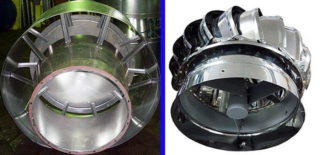
To understand how a ventilation deflector works, you need to imagine its device. It consists of the following elements:
- Diffuser - a base that looks like a truncated cone. The lower part of the flask is put on the ventilation duct, which is led out through the roof. The diffuser is designed to slow down the air flow and create increased pressure.
- An umbrella is attached to the diffuser using stands. This is a protective cap that prevents debris from entering the ventilation duct.
- The body, which is a ring.
You can find modifications that are equipped with special nets for catching small debris. But such an insert can make the thrust weaker.
The ventilation deflector works according to the following principle:
- The device catches the air flow.
- The air flows into the diffuser where it forks and reduces the pressure at the top of the ventilation duct.
- A discharged void is formed, into which air from the room enters after working out.
If the deflector on the ventilation pipe is correctly selected and installed, the pressure difference at the end of the exhaust duct will increase, and the rate of air exchange will increase.
Varieties of deflectors
The devices are presented in different design features. The deflector can be closed or open, round or square, with several cone-shaped umbrellas or with one hood.
TsAGI design
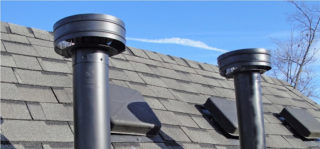
One of the varieties of the exhaust deflector is the TsAGI design.It is a cap, which is designed to increase thrust with the help of air pressure and the difference in pressure indicators.
The attachment is equipped with an additional cylindrical screen. A traditional deflector is placed inside.
Distinctive features of this design:
- Depending on the shape of the shaft throat, the connection to the air duct can be nipple, flanged and shroud.
- The ability to move the air flow from a non-aggressive environment. Steel models are able to withstand temperatures up to +800 degrees.
- In frost, ice may appear inside the cylinder. Because of it, the section will be blocked.
In calm weather, the deflector creates traction resistance.
Grigorovich model
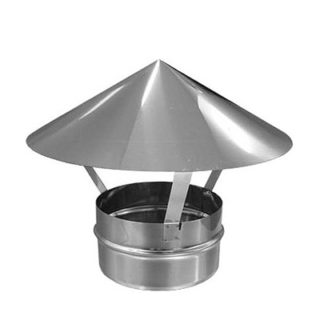
The Grigorovich device is one of the most common models that are very popular. This is due to its simplicity and affordability. The model consists of several umbrellas that are connected into one element.
The cap is installed on a pipe with a circular cross-section or mounted on top of the shaft. The air velocity under the cone at the bottom increases due to the narrowing of the duct cross-section. This leads to an increase in the pressure difference.
Open poppet construction type Astato
This device was developed in France. It is designed to enhance the draft of the exhaust air of the natural ventilation system. This is done with the help of wind and fan. The attachment can be installed on houses of any complexity and number of storeys.
Astato type structures are made of aluminum. The lineup is presented in six sizes, starting from a diameter of 16 cm, ending with 50 cm. The device can be controlled manually or automatically using a pressure sensor.
Rotary models

This type of deflector consists of a turbine head that rotates and a fixed base. The cap elements are made of thin material. Thanks to this, the drum with blades begins to spin even in light winds.
Rotary devices have several advantages:
- the efficiency of functioning is several times higher than that of static structures;
- the model will protect the room in hot weather from strong heating, thus it will be possible to reduce the cost of operating the air conditioner;
- the head of the device can look like a ball-shaped cap, which provides a pleasant aesthetic appearance;
- reduces the risk of condensation inside the roof.
The rotary air deflector can significantly save electricity, it works without the use of electricity. But this is also its disadvantage - if the weather is calm, it will not work.
H-shaped models
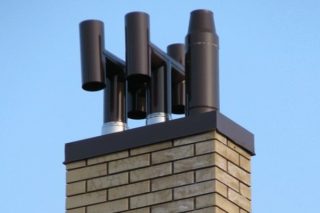
Deflectors of the letter H are designed for installation in manufacturing plants. They should increase the chimney draft and ventilation.
When installing the structure, a visor is not required, since the upper part is closed by a horizontal element.
H-shaped devices have the main advantage - they work effectively in strong gusts of wind.
Deflectors-weather vane
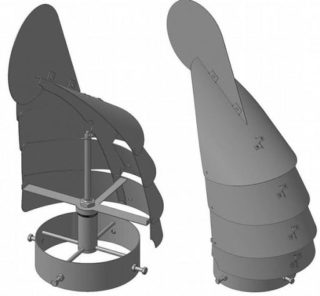
This is a deflector for the ventilation pipe, resembling a landing net in appearance. It has a semicircular shape. The device is mounted on a rod and rotates under the influence of air. A weather vane is installed at the top, which turns in the direction of the air.
The principle of operation of such a deflector is as follows:
- The weather vane turns under the pressure of air masses.
- Air flows through the curved visor.
- The currents change direction and the air tends upward.
- The speed of movement of air masses increases, the pressure begins to decrease. Thanks to this, a vacuum occurs.
The wind vane deflector is difficult to make on your own in comparison with static models.
Advantages and disadvantages
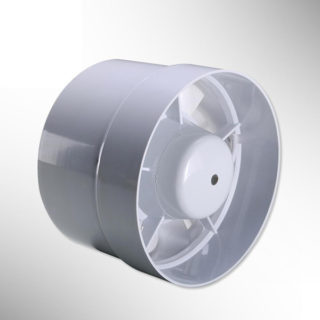
The ventilation deflector to increase the draft effectively protects the ventilation system from dirt and precipitation. If the calculation of the deflector was done correctly, the ventilation efficiency increases by 20%.
If there are light winds in the area, it is best to install a device on the system to enhance the exhaust and air flow. In this case, the effect of overturning of the thrust will be completely excluded.
The device has several disadvantages:
- If the wind direction is vertical, the stream will come into contact with the top of the structure. This will lead to the fact that the air can not be properly discharged outside.
- In winter, ice forms on the base of the pipe. To avoid problems with the functioning of ventilation, you need to regularly arrange preventive examinations.
To combat the first drawback, designs were invented that are equipped with two cones.
Installation rules
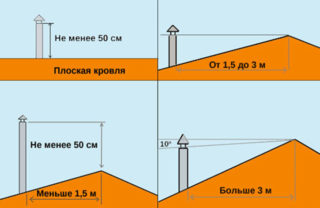
Before starting the installation of the deflector, it is recommended to study the rules and regulations of SNiP. Particular attention should be paid to the height of the ventilation pipe and hood. First you need to make a drawing so that all calculations are made correctly. The dimensions should be as follows:
- 500 mm above the roof ridge, while the duct should be 1.5 meters from the top of the roof;
- if the distance from the ventilation duct to the parapet is 1.5 meters or more, the installation should be on a par with the ridge;
- when the pipe is more than three meters away, the device is placed close to the deflection line at an angle of 10 degrees from the ridge down.
If the roof is flat, the deflector is installed at a height of 50 cm or more.
Before installing the ventilation shaft next to the chimney, you need to correctly calculate the same height of all air ducts. If this requirement is not taken into account, smoke and combustion products will enter the house.
There are several installation nuances that need to be taken into account:
- Do not mount the device in the aerodynamic area of adjacent buildings.
- The deflector must be installed in the area of free airflow. It is best if the hood is the highest point on the roof.
If a round nozzle is to be installed on a square duct, an adapter must be used for this.
Features of choice

There are many types of wind devices. They are divided into groups depending on the structure and principle of operation. When choosing a suitable model, it is recommended to pay attention to the following nuances:
- construction material;
- the principle of functioning;
- individual features of the device.
Manufacturing material
Most often, wind nozzles are made from stainless steel, plastic, galvanized steel, aluminum. The simplest models can be made by yourself. The most practical are aluminum and galvanized steel structures. Such products from copper can be rarely found, since their cost is quite high. Only basement structures are made of plastic, since the material is very fragile. The deflector for the chimney is made of metal.
Classification according to the principle of operation
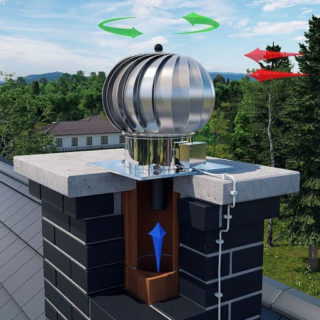
Varieties according to the principle of the functioning of the nozzles:
- Static are the simplest structures that you can assemble yourself. They are installed on ventilation ducts in high-rise buildings and small enterprises.
- Turbo deflectors are rotating blade designs. The base is completely static and the head rotates.
- Weather vane installed on the shaft of the ventilation duct. It rotates according to the direction of the wind.
By installing a deflector, you can secure and extend the life of the ventilation system, as well as improve its performance.








